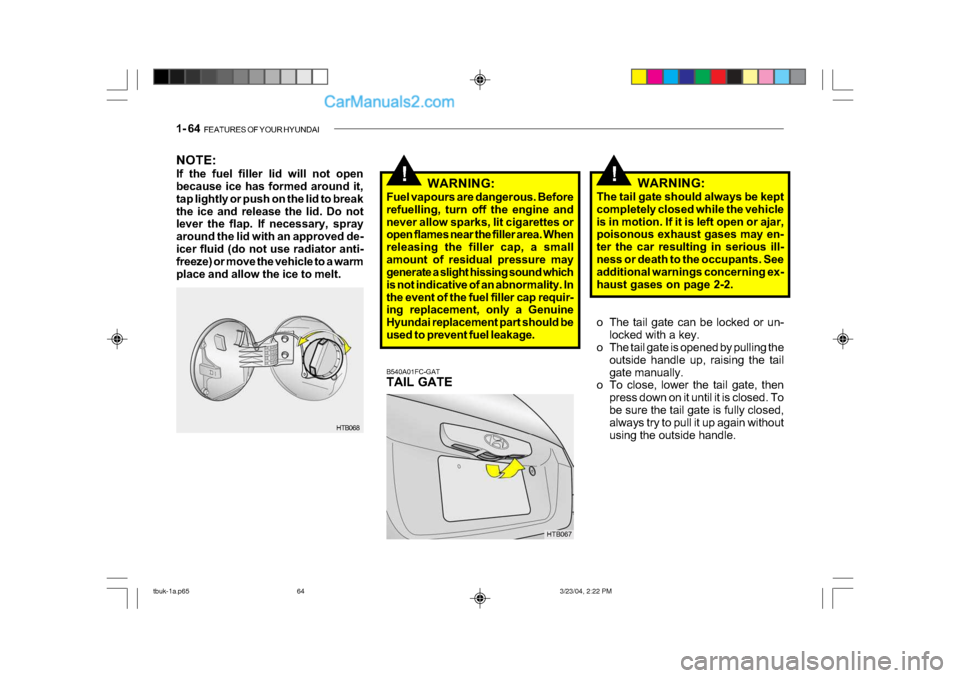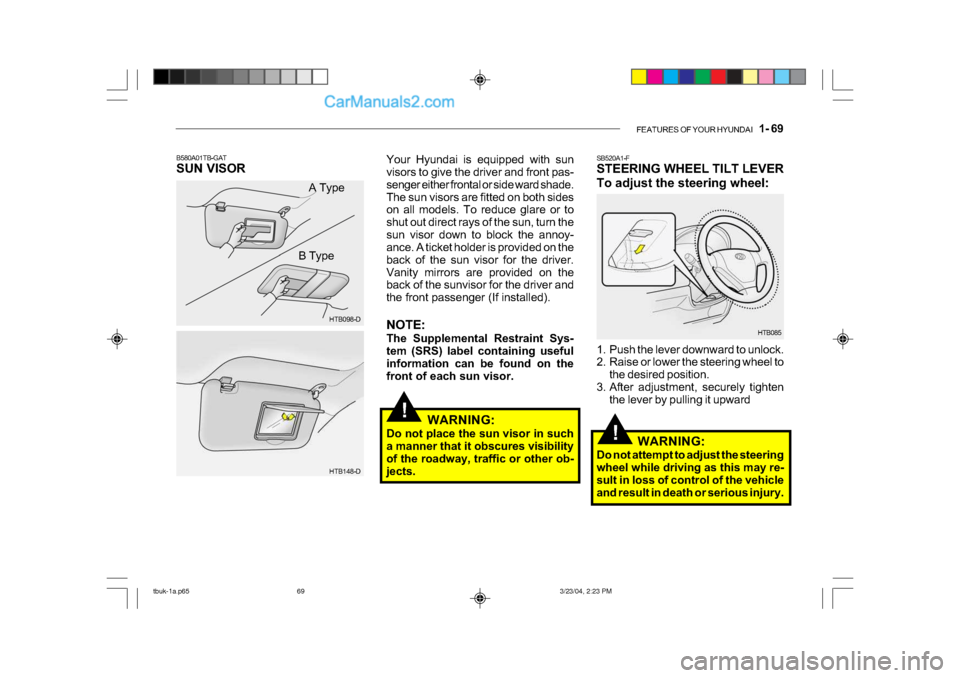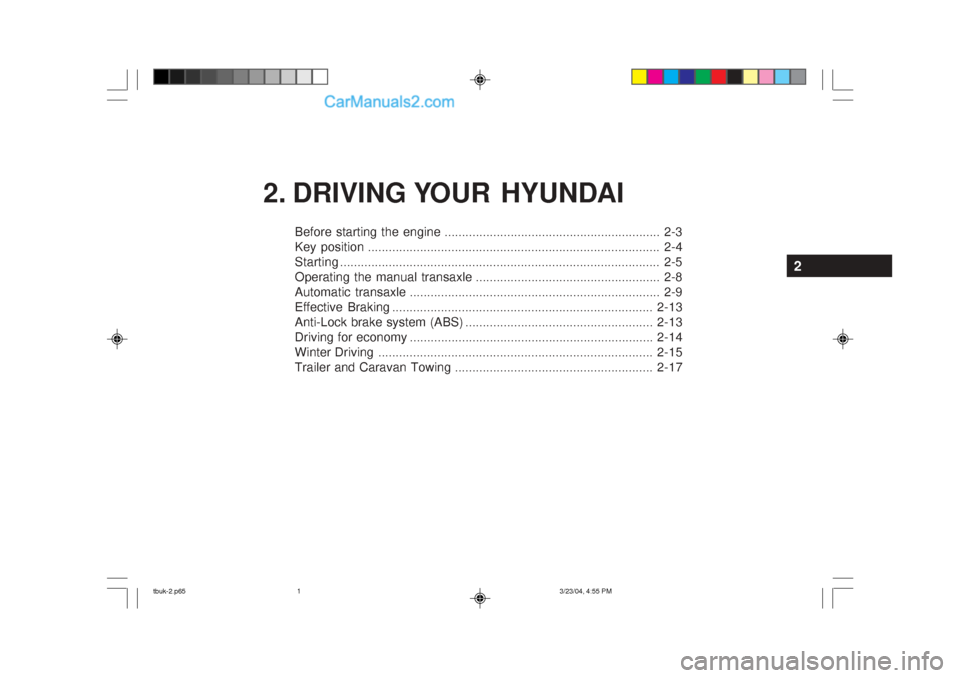2004 Hyundai Getz lock
[x] Cancel search: lockPage 321 of 445

FEATURES OF YOUR HYUNDAI 1- 63
!
SB440A2-E
REMOTE FUEL FILLER LID
RELEASE (Not all models)
The fuel filler lid may be opened from
inside the vehicle by pulling up on the
fuel filler lid release.
HTB115-D
Before closing the bonnet, return the
support rod to its clip to prevent it from
rattling. Lower the bonnet until it is
about 30 cm (1 ft.) above the closed
position and let it drop. Make sure that
it locks into place.
HTB288
3. Pull the support rod from the bonnet.
HTB308
CAUTION:
Make sure that the support rod has
been released prior to closing the
bonnet.
4. Hold the bonnet open with the sup- port rod. WARNING:
o Always double check to be sure that the bonnet is firmly latched
before driving away. If it is not
latched, the bonnet could fly open
while the vehicle is being driven,
causing a total loss of visibility,
which might result in an accident.
o The support rod must be inserted completely into the hole provided
in the bonnet whenever you in-
spect the engine compartment.
This will prevent the bonnet from
falling and possibly injuring you. o Do not move the vehicle with the
bonnet in the raised position, as
vision is obstructed and the bon-
net could fall or be damaged.
!
tbuk-1a.p65 3/23/04, 2:22 PM
63
Page 322 of 445

1- 64 FEATURES OF YOUR HYUNDAI
!!
NOTE:
If the fuel filler lid will not open
because ice has formed around it,
tap lightly or push on the lid to break
the ice and release the lid. Do not
lever the flap. If necessary, spray
around the lid with an approved de-
icer fluid (do not use radiator anti-
freeze) or move the vehicle to a warm
place and allow the ice to melt.
B540A01FC-GAT
TAIL GATE
HTB067WARNING:
The tail gate should always be kept
completely closed while the vehicle
is in motion. If it is left open or ajar,
poisonous exhaust gases may en-
ter the car resulting in serious ill-
ness or death to the occupants. See
additional warnings concerning ex-
haust gases on page 2-2.
HTB068 WARNING:
Fuel vapours are dangerous. Before
refuelling, turn off the engine and
never allow sparks, lit cigarettes or
open flames near the filler area. When
releasing the filler cap, a small
amount of residual pressure may
generate a slight hissing sound which
is not indicative of an abnormality. In
the event of the fuel filler cap requir-
ing replacement, only a Genuine
Hyundai replacement part should be
used to prevent fuel leakage. o The tail gate can be locked or un-
locked with a key.
o The tail gate is opened by pulling the
outside handle up, raising the tail
gate manually.
o To close, lower the tail gate, then
press down on it until it is closed. To
be sure the tail gate is fully closed,
always try to pull it up again without
using the outside handle.
tbuk-1a.p65 3/23/04, 2:22 PM
64
Page 327 of 445

FEATURES OF YOUR HYUNDAI 1- 69
!
!
SB520A1-F
STEERING WHEEL TILT LEVER
To adjust the steering wheel:
1. Push the lever downward to unlock.
2. Raise or lower the steering wheel to
the desired position.
3. After adjustment, securely tighten the lever by pulling it upward
WARNING:
Do not attempt to adjust the steering
wheel while driving as this may re-
sult in loss of control of the vehicle
and result in death or serious injury.
Your Hyundai is equipped with sun
visors to give the driver and front pas-
senger either frontal or side ward shade.
The sun visors are fitted on both sides
on all models. To reduce glare or to
shut out direct rays of the sun, turn the
sun visor down to block the annoy-
ance. A ticket holder is provided on the
back of the sun visor for the driver.
Vanity mirrors are provided on the
back of the sunvisor for the driver and
the front passenger (If installed).
NOTE:
The Supplemental Restraint Sys-
tem (SRS) label containing useful
information can be found on the
front of each sun visor.
WARNING:
Do not place the sun visor in such
a manner that it obscures visibility
of the roadway, traffic or other ob-
jects.
HTB098-D
B580A01TB-GAT
SUN VISOR
HTB148-D
A Type
B Type
HTB085
tbuk-1a.p653/23/04, 2:23 PM
69
Page 335 of 445

FEATURES OF YOUR HYUNDAI 1- 77
B740A01A-AAT
AIR CONDITIONING SWITCH
(Not all models)
B730A01FC-EAT
Operation Tips
o To keep dust or unpleasant fumes
from entering the car through the
ventilation system, temporarily set
the air intake control at "Recircula-
tion". Be sure to return the control to
"Fresh" when the irritation has
passed to keep fresh air in the ve-
hicle. This will help keep the driver
alert and comfortable.
o Air for the heating/cooling system is
drawn in through the grilles just
ahead of the windscreen. Care should
be taken that these are not blocked
by leaves, snow, ice or other ob-
structions.
o To prevent interior fog on the
windscreen, set the air intake control
to the fresh air ( ) position and
fan speed to the desired position.
To remove the frost or exterior
fog on the windscreen:
o Set the air intake control to the fresh
( ) position.
o Set the air flow control to the defrost ( ) position
o Set the temperature control to warm.
o Set the fan speed control to position
"3" or "4".
NOTE:
When the A/C is operated continu-
ously on the floor-defrost level ( )
or defrost level ( ), it may cause
fog to form on the exterior
windscreen. If this occurs, set the air
flow control to the face level posi-
tion ( ) and fan speed control to
the low position. The air conditioning is turned on by
pushing the A/C button on the heating/
air conditioning control panel.
HTB037-D
tbuk-1b.p65
3/23/04, 2:24 PM
77
Page 339 of 445

FEATURES OF YOUR HYUNDAI 1- 81
!
B750A04L B750A05L
o Station Swapping - As a FM signal weakens, another more powerful
signal near the same frequency may
begin to play. This is because your
radio is designed to lock onto the
clearest signal. If this occurs, select
another station with a stronger sig-
nal.
o Multi-Path Cancellation - Radio sig- nals being received from several
directions can cause distortion or
fluttering. This can be caused by a
direct and reflected signal from the
same station, or by signals from two
stations with close frequencies. If
this occurs, select another station
until the condition has passed.
o Fading - As your car moves away
from the radio station, the signal will
weaken and sound will begin to
fade. When this occurs, we suggest
that you select another stronger sta-
tion.
o Flutter/Static - Weak FM signals or
large obstructions between the
transmitter and your radio can dis-
turb the signal causing static or flut-
tering noises to occur. Reducing the
treble level may lessen this effect
until the disturbance clears. B750B02Y-AAT
Using a cellular phone or a two-
way radio
When a cellular phone is used inside
the vehicle, noise may be produced
from the audio equipment. This does
not mean that something is wrong with
the audio equipment. In such a case,
use the cellular phone at a place as far
as possible from the audio equipment.
!
CAUTION:
When using a communication sys-
tem such a cellular phone or a radio
set inside the vehicle, a separate
external antenna must be fitted.
When a cellular phone or a radio set
is used with an internal antenna
alone, it may interfere with the
vehicle's electrical system and ad-
versely affect safe operation of the
vehicle.
WARNING:
Don't use a cellular phone when
you are driving, you must stop at a
safe place to use a cellular phone.
tbuk-1b.p65 3/23/04, 2:24 PM
81
Page 342 of 445

1- 84 FEATURES OF YOUR HYUNDAI
HTB111
B870D01FC-GAT
ANTENNA
Roof Antenna
Your car uses a roof antenna to re-
ceive both AM and FM broadcast sig-
nals.
This antenna is a removable type. To
remove the antenna, turn the antenna
counterclockwise. To install the an-
tenna, turn the antenna clockwise.
o The playback head, capstan and
pinch rollers will develop a coating
of tape residue that can result in
deterioration of sound quality, such
as a wavering sound. They should
be cleaned monthly using a com-
mercially available head cleaning
tape or special solution available
from audio specialty shops. Follow
the supplier's directions carefully and
never oil any part of the tape player
unit.
o Always be sure that the tape is tightly wound on its reel before in-
serting in the player. Rotate a pencil
in the drive sprockets to wind up any
slack. B860A03L
NOTE:
Look at a tape before you insert it.
If the tape is loose, tighten it by
turning one of the hubs with a pen-
cil or your finger.
If the label is peeling off, do not put
it in the drive mechanism.
Do not leave tapes sitting where
they are exposed to hot, warm, or
high humidity, such as on top of
the dashboard or in the player.
If a tape is exposed to extreme heat
or cold, let it reach a moderate tem-
perature before putting it in the
player.
tbuk-1b.p65 3/23/04, 2:24 PM
84
Page 344 of 445

2. DRIVING YOUR HYUNDAIBefore starting the engine .............................................................. 2-3
Key position .................................................................................... 2-4Starting ............................................................................................ 2-5
Operating the manual transaxle ..................................................... 2-8
Automatic transaxle ........................................................................ 2-9
Effective Braking ........................................................................... 2-13
Anti-Lock brake system (ABS) ...................................................... 2-13
Driving for economy ...................................................................... 2-14
Winter Driving ............................................................................... 2-15
Trailer and Caravan Towing ......................................................... 2-17
2
tbuk-2.p65 3/23/04, 4:55 PM
1
Page 346 of 445

DRIVING YOUR HYUNDAI 2- 3
!
C020A01O-EAT BEFORE STARTING THE EN- GINE Before you start the engine, you should always:
1. Look around the vehicle to be sure
there are no flat tyres, puddles of oil or water or other indications of pos- sible trouble.
2. After entering the car, check to be
sure the parking brake is engaged.
3. Check that all windows, and lights are clean.
4. Check that the interior and exterior
mirrors are clean and in position.
5. Check your seat, seatback and
headrestraint to be sure they are intheir proper positions.
6. Close all the doors.
7. Fasten your seat belt and be sure
that all other occupants have fas- tened theirs.
8. Turn off all lights and accessories that are not needed.
9. When you turn the ignition switch to "ON" check that all appropriate warn-ing lights are operating and that youhave sufficient fuel. 10.Check the operation of warning
lights and all bulbs when key is inthe "ON" position.
WARNING: (DIESEL ENGINE)
To ensure that sufficient vacuum exists within the brake system dur-ing cold weather start-up condi-tions, it is necessary to run theengine at idle for several seconds after starting the engine. SC040A1-F COMBINATION IGNITION SWITCH AND STEERING LOCK To Start the Engine
o If your Hyundai is equipped with a
manual transaxle, place the shift lever in neutral and depress theclutch pedal fully.
o If your Hyundai has an automatic
transaxle, place the shift lever in "P" (park).
o To start the engine, insert the igni-
tion key and turn it to the "START" position. Release it as soon as theengine starts. Do not hold the key inthe "START" position for more that 15 seconds.
NOTE: For safety, the engine will not start if the shift lever is not in "P" or "N"Position (automatic transaxle).
tbuk-2.p65 3/23/04, 4:55 PM
3